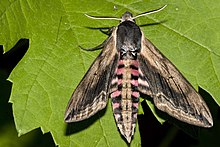|
Species of moth
| Privet hawk moth
|

|
Scientific classification 
|
| Domain:
|
Eukaryota
|
| Kingdom:
|
Animalia
|
| Phylum:
|
Arthropoda
|
| Class:
|
Insecta
|
| Order:
|
Lepidoptera
|
| Family:
|
Sphingidae
|
| Genus:
|
Sphinx
|
| Species:
|
S. ligustri
|
| Binomial name
|
Sphinx ligustri
|
| Synonyms
|
- Sphinx chishimensis Matsumura, 1929
- Sphinx spiraeae Esper, 1800
- Sphinx ligustri albescens Tutt, 1904
- Sphinx ligustri amurensis Oberthür, 1886
- Sphinx ligustri brunnea Tutt, 1904
- Sphinx ligustri brunnescens (Lempke, 1959)
- Sphinx ligustri cingulata (Lempke, 1964)
- Sphinx ligustri eichleri Eitschberger, Danner & Surholt, 1992
- Sphinx ligustri fraxini Dannehl, 1925
- Sphinx ligustri grisea (Closs, 1917)
- Sphinx ligustri incerta Tutt, 1904
- Sphinx ligustri intermedia Tutt, 1904
- Sphinx ligustri lutescens Tutt, 1904
- Sphinx ligustri nisseni Rothschild & Jordan, 1916
- Sphinx ligustri obscura Tutt, 1904
- Sphinx ligustri pallida Tutt, 1904
- Sphinx ligustri perversa Gehlen, 1928
- Sphinx ligustri postrufescens (Lempke, 1959)
- Sphinx ligustri rosacea Rebel, 1910
- Sphinx ligustri seydeli Debauche, 1934
- Sphinx ligustri subpallida Tutt, 1904
- Sphinx ligustri typica Tutt, 1904
- Sphinx ligustri unifasciata Gschwandner, 1912
- Sphinx ligustri weryi Rungs, 1977
- Sphinx ligustri zolotuhini Eitschberger & Lukhtanov, 1996
|
Sphinx ligustri, the privet hawk moth, is a moth found in most of the Palearctic realm. The species was first described by Carl Linnaeus in his 1758 10th edition of Systema Naturae.
Description
It has a 12 centimetres (4.7 in) wingspan (generally deflexed at rest), and is found in urban areas, forests and woodlands.
The male privet hawk moth can make a hissing sound, if disturbed, by rubbing together a set of scales and spines at the end of its abdomen.[2]
The larvae are usually found between July and August: and bury themselves in the earth when preparing to become a pupa. They then fly in the following June.[3]
Diet
As both its common name and specific name - ligustri being derived from the Latin ligustrum, 'privet' - describes, the caterpillars feed on privets, as well as ash trees, lilacs, jasmine, and a number of other plants.
Gallery
-
Female, dorsal side
-
Female, ventral side
-
Male, dorsal side
-
Male, ventral side
References
External links
|








